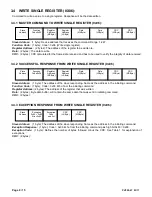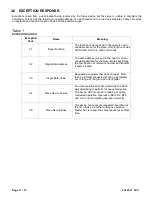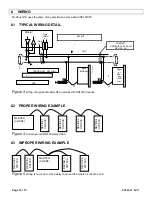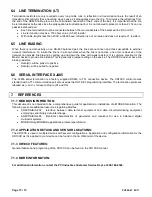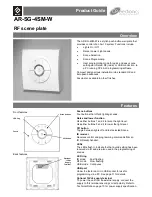
Page 4 / 15
PV500-67 03/17
Line Termination: (LT)
On RS-485, ideally the two ends of the cable will have a termination resistor connected across
the two wires. This helps with reducing noise and interference on high speed and long line lengths. In practice, it is not
needed in low speed and short line lengths. When needed, adding a 150ohm resistor across the line at the end devices
will reduce electrical noise and reflections.
Biasing Resistors:
One device on the RS-485 line should have biasing resistors. This holds the line in a known state
when no devices are transmitting (talking). Typically this would be the Master device.
XR10CX Implementation:
Modbus RTU protocol, over RS-485 (EIA-485) physical layer using 2 wires. Each XR10CX
should be considers 1 UNIT LOAD for the network loading. The XR10CX devices do not have biasing resistors.
XR10CX will operate in slave mode and will only transmit when addressed by the Master device.
Registers: (Holding Registers)
Each Register is 1 word defined as 2 bytes or 16 bits. See Table 2 for details of each
Register. Holding registers are typically READ/WRITE but can be READ ONLY or WRITE ONLY. The XR10CX uses
this type of register. All Registers are in the range of 40001-4999.
Coils: (Output Coils or Boolean Variables)
The XR10CX support and uses Output Coils. Each coil is 1 bit and can
be read or written to. Despite the name, they can be digital outputs, Boolean variables, or digital inputs.
Register Numbers / Register Addresses:
Modbus can be confusing when referencing registers and their addresses.
Modbus documentation is not consistent and terms are used interchangeably when they have different meanings.
Register Addresses always start at 0 and count up, and Register Numbers are the actual number/name of the Register.
Example the first Holding Register is 40001. This would be address 0. For each data type, the address would start at
0 again. To avoid confusion, this manual will reference Register Numbers only. Any reference to a Register less than
40000 simply needs the 40000 added to it. Setpoint ST1 is Register 769 or the actual Register Number 40769. For a
list of all available registers, see Table 2.
Input Registers, Discrete Inputs and Coils:
MODBUS defines several types of data. The only data used by the
XR10CX
®
is the Holding Register (40001
– 49999) and Output Coils (00001 – 09999). The XR10CX does not use
Input Registers, or Inputs Coils.
CRC ERROR CHECKING:
Modbus-RTU includes an error-checking field that is based on a Cyclical Redundancy
Checking (CRC) method performed on the message contents. The CRC field checks the contents of the entire
message. The CRC field contains a 16-bit value as the last 2 bytes in any message. The low-order byte of the field is
appended first, followed by the high-order byte. The CRC value is calculated by the sending device, which appends
the CRC to the message. The receiving device recalculated a CRC during receipt of the message, and compares the
calculated value to the actual value it received in the CRC field. If the two values are not equal, the message will be
ignored. Most Energy Management software packages will automatically calculate the CRC values as a normal part of
the protocol.
2.2 COMMUNICATION DETAILS:
The MODBUS application data unit is built by the Master (client) that initiates a MODBUS transaction. The function
indicates to the slave (server) what kind of action to perform. The function code field of a MODBUS data unit is coded
in one byte. When a message is sent from a Master to a Slave device the function code field tells the Slave what kind
of action to perform. The message contains information that the Slave uses to take the action defined by the function
code. If no error occurs in receiving the message from the Master, the slave will respond to the Master. The response
(Slave to Master) message contains the data requested, if no da
ta was requested, it will echo the Master’s command.
See Figure 1 for a diagram of a successful communication. If the slave is unable to execute the command (example:
invalid command, unreachable address), the message contains an error code and an exception code. See Figure 2 for
diagram of an exception response. See Table 1 for a list of exception codes.









